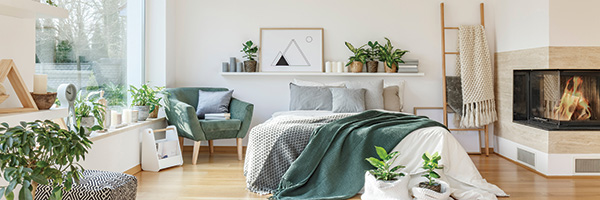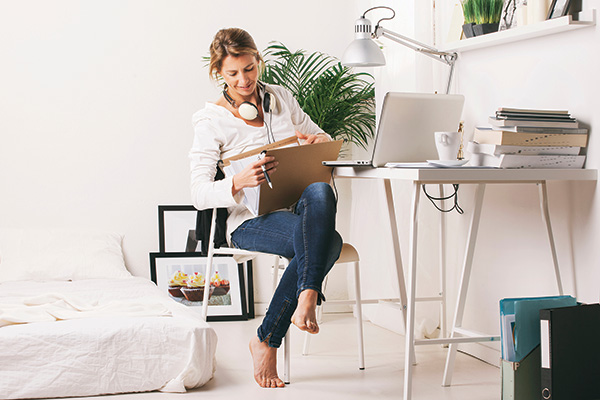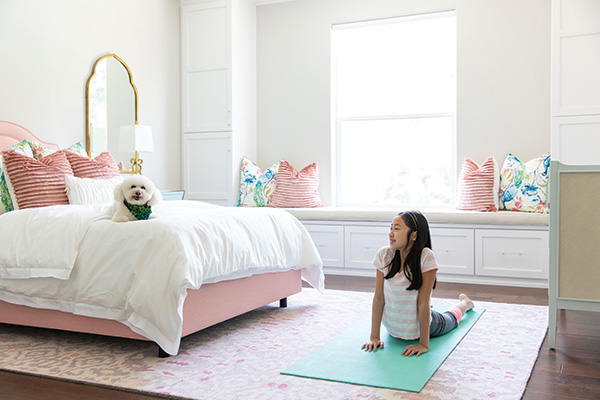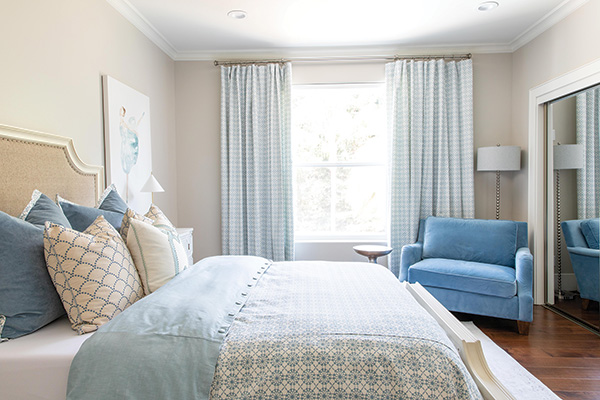How has the pandemic changed the bedroom? Before, it was a place to sleep. Today, it is much, much more.

In the spring of 2020, the pandemic erupted. Schools and offices shut down, and everyone retreated to their homes. At that time, people had one thing in common: They weren’t ready to go home, and their homes weren’t ready for them.
As Americans sheltered in place, they realized the insufficiencies of their living quarters. The U.S. Census Bureau’s American Housing Survey reports that in 2019, about 38% of multi-person homes in the United States did not have at least two full bathrooms or enough bedrooms (which is defined as a two- or three-person household having at least two bedrooms). Additionally, the Census Bureau’s Household Pulse Survey reveals that from January 2020 to February 2021, some 91 million Americans shifted workstations and classrooms to their homes.
Suddenly, everyone was trying to squeeze offices into dining rooms (or they said goodbye to the guest bedroom). And they began to view the primary bedroom as more than just a place to sleep at the end of the day: It became a retreat from the rest of the household, a private sanctuary where they could escape for some peace and quiet.
The main bedroom became a much more important area of the house. According to Yahoo Finance, 20% of homeowners made upgrades to their home’s primary bedroom amid the pandemic.
“During the pandemic, the bedroom became a catch-all for rest, work and those in-between at-home moments,” says celebrity designer Kerrie Kelly. “Now the bedroom is an edited, thoughtful place of respite, focused on wellness.”

To create a Zen sleep space, the first thing many did was buy a mattress. By the fall of 2020, mattress sales were already up 30% year over year. Mattress factories worked 24/7 to keep up with the soaring demand. Weighted blankets, designed to make consumers feel safe and to quiet the nervous system, became more mainstream, and adjustable bases became more popular as some folks chose to work in bed.
Clean, healthy sleep
During the pandemic, some bedding brands partnered with spa and wellness resorts to introduce private label mattress brands, while other manufacturers emphasized the importance of sleep to physical health and maintaining immunity. This focus on health and wellness not only came across in the mattress’ features (think lavender aromatherapy), but also in their marketing messages. Covid-19 sparked a health and wellness trend that continues to be important for the bedding industry today.
With the new emphasis on staying home and staying well, Kelly now chooses mattresses for her clients based on their sleeping preferences. She noticed a shift during the pandemic, which still holds true today: “We’ve found our clients leaning toward mattresses that elevate their resting and sleeping experiences,” says Kelly, creative director of Kerrie Kelley Design Lab in Sacramento, California. “Our clients are looking for premium materials that support their bodies for a good night’s sleep. Pressure relief, motion isolation and cooling technology are all features to be considered.”
Soft, soothing spaces
With new mattresses in place, homeowners began feathering their nests. They sought comfort, balance and calm — and they were willing to pay for it.
“Clients wanted to create a space to escape from the reality of the pandemic,” says Steve McKenzie, co-owner of McKenzie Interior Design in Atlanta. “We have updated a lot of primary bedrooms with new bedding, accents and art to create a cozy place to relax.”
He recalls one pandemic project where he painted a primary bedroom in soothing blues. “We used really comfortable bedding and chairs for reading — all to create an oasis for the client to escape the realities of the world,” McKenzie says.
And since consumers were homebound and flush with cash thanks to a shift in lifestyle, such as curbing their restaurant habit, they were ready to spend more money on their homes.

“Clients are more willing to invest in high-quality furniture and finer fabrics; they really understand the value of investing in things they love,” says Anne Rainey Rokahr, owner and lead designer of Trouvaille Home in Winston-Salem, North Carolina.
Kelly noted a similar trend among her clients. “We are finding more requests for luxurious sheets, cozy blankets, chairs for reading and layered lighting in bedroom areas along with paint palettes that soothe,” she says.
In contrast to the monochromatic interior, Better Homes & Gardens reports that 2022 bedroom trends are evolving to emphasize color, intricate headboards, artwork and natural elements, such as plants — a way to feel connected with nature and to bring the outside in.
Let there (not) be light
Not only is it important to bring natural elements indoors — natural light is crucial. While consumers have begun to put more emphasis on brightening up living spaces, they’re now darkening bedrooms to sleep more soundly.

of the modern bedroom, now viewed as a sleep sanctuary.
“Newer construction usually means a larger footprint that takes up most of a lot’s acreage,” says Janet Rabe-Meyer, a Keller-Williams real estate agent with territory in South Daytona, Florida. With less room for landscaping and natural shade, new homeowners have started inventively using shades that “can transition to light in a room or make a bedroom opaque,” Rabe-Meyer says.
In addition to shades, sales of blackout curtains climbed during the pandemic. The global blackout curtains market size was estimated to be worth about $11 million in 2021, and it’s forecast to be $13.9 million by 2028, according to MarketWatch.
“With mental health being a primary focus, clients are looking to get an optimal night’s sleep. This means detaching from technology, embracing comfort and incorporating sustainable materials,” Kelly says. “From 2020 to now, we have updated a series of bedrooms by using neutral and muted colors, versatile window coverings, luxurious materials and organic details to create a sleep sanctuary.”
Side-hustle bedroom
While 20% of those surveyed by Yahoo Finance upgraded their primary bedroom during the pandemic, 11% remodeled the secondary bedroom (or bedrooms) into office space.
Rokahr says her design mantra has always been “more furniture but smaller spaces.” The concept gained steam during the pandemic, when she noticed two camps of stay-at-home workers: Those who were new to the situation “just made do — usually spreading out on the dining room table or in a living room or den. They just accepted that the room was going to remain a mess for the duration and that was the end of it.”
On the other hand, she notes, “the ones who love working from home were willing to redesign a primary room like a dining or living room (or guest bedroom) to be an office. All of them wanted a luxurious space: antique desks, custom swivel chairs in front; fine art or custom drapes for a Zoom background. The works.”
Warren Satchell, consultant and director with WGSN, a global trend forecasting company, noted the same shift in his Trend Talk at ISPA EXPO, describing the new “side-hustle bedroom.”
“With an entrepreneurial mindset, the bedroom takes on layers of activities from filming studios to warehouse and shipment facilities,” Satchell said. “This is where immersive and quick decor can come in. Think pillows, fabric backdrops and postcards stuck to the walls like wallpaper, either personally curated or purchased in packs from retailers such as Etsy, eBay or Amazon to cost-
effectively create this aesthetic that changes as our needs evolve.”
Home optimization
As consumers re-examined their living spaces and confronted new needs for classroom space and offices at home, the idea arose that they should “optimize” their abodes — or reconfigure the existing space to best suit the new needs.

Think luxurious sheets, cozy blankets and peaceful artwork.
“Home optimization is encouraging homeowners to effectively live, work and relax in their own space, truly allowing the home to support our lifestyles,” Kelly says. In her world of high design, the primary bedroom can also be referred to as the “owner’s suite.”
“While the owner’s suite is moving toward a simplified tech-free sanctuary, the guest bedroom spaces are becoming workhorses for yoga studios, offices, sleeping quarters, dressing rooms, playrooms and Peloton studios,” she says. “Sliding walls, Murphy beds and hidden niches are all on the table when designing guest bedrooms today.”
Or, perhaps the best strategy is separating all the bedrooms and having the primary bedroom on the first floor and the guest bedrooms (or now offices) upstairs. Then, at the end of the day, you can shut the door to your “office” and come downstairs for your evening as a way to better mentally separate work from home.
Just ask new homeowners Liz and Asa Beavers. “A bedroom must-have for us was a little separation from our 1-year-old,” Liz Beavers says. “In our previous home, we practically shared
a wall — and for any parent of a teething little one, you know the struggle. But with a first-floor main bedroom, everyone sleeps better. It also feels like a bit of a retreat.”
But the Beavers’ primary concern was (in lieu of guest bedrooms) creating separate office space upstairs, critical for remote tech executives in North Carolina’s Research Triangle. “Gone are the days of taking down my ‘office’ in the dining room when folks come to dinner,” she says. “We shut down, come downstairs, and feel like we’re ‘leaving work’ at the end of the day.”
Today, two and a half years after the pandemic began, Americans are still returning to a sense of “normalcy” — true. But on a positive note, they have much-improved homes to thank for it — and new spa-fresh and side-hustle bedrooms.
Nancy Oakley contributed to this article.




